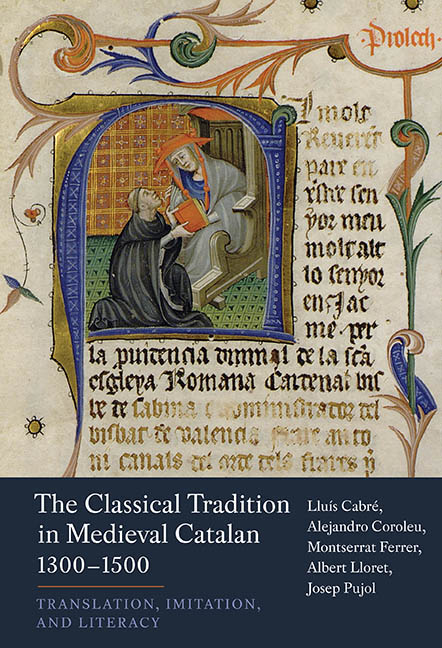Book contents
- Frontmatter
- Contents
- List of Maps
- Preface
- List of Abbreviations
- Part I The Classical Tradition in Medieval Catalan
- 1 Historical Background
- 2 Literacy: Translations and Royal Patronage
- 3 Imitation: The Classical Tradition in the Works of Five Major Authors
- 4 Printing: Humanism and the Renaissance
- Part II Catalogue of Translations to 1500
- Appendix 1 Italian Renaissance: Printed Editions, 1473–1535
- Appendix 2 Rulers of the Crown of Aragon, 1137–1516
- Bibliography
- Index of Manuscripts
- Index
4 - Printing: Humanism and the Renaissance
from Part I - The Classical Tradition in Medieval Catalan
Published online by Cambridge University Press: 03 July 2019
- Frontmatter
- Contents
- List of Maps
- Preface
- List of Abbreviations
- Part I The Classical Tradition in Medieval Catalan
- 1 Historical Background
- 2 Literacy: Translations and Royal Patronage
- 3 Imitation: The Classical Tradition in the Works of Five Major Authors
- 4 Printing: Humanism and the Renaissance
- Part II Catalogue of Translations to 1500
- Appendix 1 Italian Renaissance: Printed Editions, 1473–1535
- Appendix 2 Rulers of the Crown of Aragon, 1137–1516
- Bibliography
- Index of Manuscripts
- Index
Summary
As noted in Chapter 2, towards the end of the fourteenth century royal servants – chancery scribes and secretaries – gradually adopted a more polished style in both Latin and Catalan, occasionally modelled on Cicero. Official correspondence in Latin was the most important task of those responsible for secular administration, such as the royal secretary Bernat Metge, whom we have already encountered (pp. 54–6 and 93–8). A good example of the way in which Metge engages with Cicero is provided by a Latin letter of 17 October 1408 written on behalf of King Martin to the councillors of the Sardinian town of Oristano, whose support the monarch is eager to secure in his fight against William II of Narbonne (Taylor 2012: 137–9). Here Metge's style adopts several features typical of the Roman orator. One key characteristic of Ciceronian style is the use of periodic sentences, a device imitated by Metge from the outset. The first two sentences, comprising twelve lines, include a series of subordinate clauses (relative, conditional, and participial phrases), which allow the text to unfold gradually. In the opening sentence the main idea is emphasized by being placed at the end:
Quanta conceperimus alacritate animique quiete, quantoque mentis jubilo, quantaque cordis aviditate laudabiles actus vestros […], lingua vix seu calamo exprimere valeremus.
(With how much alacrity and tranquillity, with how much joy, with how much eagerness of the heart we have received your honourable deeds […], we shall barely be able to express with our tongue or our pen.)
Throughout his epistle Metge resorts to parallel structures, chiefly through tripartite sentences: ‘Venit enim tempus quo fletus vester in gaudium, planctus in plausum, et in libertatem captivitas redigetur’ (‘A time will come in which your tears will turn into joy, your lamentations into applause, and into liberty your captivity’). The style is additive, often by means of rhetorical questions: ‘Ubi est deus tuus? Ubi latitat? Ubi dormit?’ (‘Where is your god? Where is he hiding? Where is he sleeping?’).
In the course of their daily work, these dictatores commonly resorted to compilations of extracts from other writings. A good example is a Latin florilegium included in Montserrat, MS 981, which features collections of sentences from classical authors (Livy, Plato, Ptolemy) and writers on spiritual matters (Bernard of Clairvaux), as well as a series of mnemonic devices.
- Type
- Chapter
- Information
- The Classical Tradition in Medieval Catalan, 1300–1500Translation, Imitation, And Literacy, pp. 123 - 154Publisher: Boydell & BrewerPrint publication year: 2018



